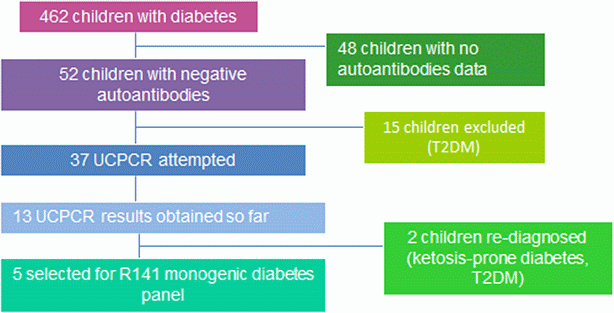BSPED2024 Poster Presentations Diabetes 6 (8 abstracts)
Searching for hidden MODY in a paediatric diabetes clinic – a clinical review
Anis Fozi 1 , Dhivyalakshmi Jeevarathnami 2 , Pooja Sachdev 1 & Rachel Williams 1
1Nottingham University Hospitals NHS Trust, Nottingham, United Kingdom; 2Sri Ramachandra Medical College, Chennai, India
Question: What is the Prevalence of undiagnosed Monogenic diabetes mellitus when a formal case ascertainment protocol is followed?
Background: The estimated prevalence of monogenic diabetes in the UK is 3.6%. The UNITED study (Shields et. al 2017) reported the use of urinary c-peptide:creatinine ratio (UCPCR) and autoantibodies as biomarkers to screen diabetes cohorts diagnosed at <30y and currently <50y in two UK cities. Cases found to have UCPCR≥0.2nmol/ mmol had autoantibody testing (GAD and IA2). Those with negative autoantibodies then had genetic testing for monogenic diabetes. MODY rates in our clinic are 0.6% (Table 1).
Methods: A modified version of the UNITED protocol was used to screen our patients for monogenic diabetes. We aim to send autoantibodies (GAD, IA2 and ZnTr8) in all newly diagnosed patients. UCPCR was measured in CYP with diabetes duration >3yrs and negative autoantibodies. Those with UCPCR≥0.2nmol/ mmol and not phenotypical of type 2 diabetes mellitus, underwent molecular genetic testing for monogenic diabetes (R141).
Results: Rates of monogenic diabetes in our clinic population were lower than reported in other studies (Figure 1). Results are summarised in Figure 1.
| Diabetes Type | n, % |
| Type 1 Diabetes | 418 (90.5%) |
| Type 2 Diabetes | 27 (5.8%) |
| CFRD Diabetes | 5 (1.1%) |
| MODY | 3 (0.6%) |
| Other | 9 (1.9%) |

Discussion: Using biomarkers for MODY screening within a clinical has limitations. Collection of UCPCR 2 hours after a large carbohydrate meal was challenging which may increase rates of false negative UCPCR and reducing case detection. Some autoantibodies were measured >5 years from diagnosis which could increase false positives, leading to unnecessary costs. To date, one child has been re-classified as ketosis-prone diabetes and was able to come off insulin. If all 5 children selected for genetic testing ultimately have a monogenic diagnosis, the prevalence rate in our clinic would be 1.9%, which would be below that reported in the UNITED study. Despite variations in genetic testing rates, we wonder whether there could be regional genetic clustering of MODY.




